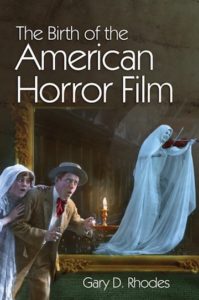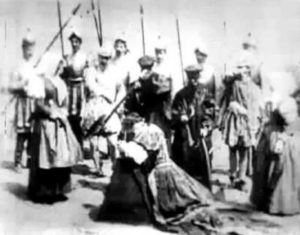
In this week’s programme I talk to film historian Gary D Rhodes about the birth of the American horror film. Gary’s book is a fascinating exploration of the first two decades of cinema before the first world war when everything was still new and untried. Horror didn’t yet exist as a genre but it’s astonishing to see how many of the themes and tropes that we’re familiar with today had already been experimented with by 1915: vampires, ghosts, possessions; Jekyll and Hyde; Frankenstein and his monster; the mad scientist with his bubbling test tubes; even the haunting that is unmasked as a con trick all made their first screen appearances in those first twenty years.
In the interview, Gary tells me about the first special effect in the history of the cinema, used in the 1895 film, Execution of Mary, Queen of Scots. A contemporary newspaper advertisement called it ‘blood-curdling in the extreme’:
gary d rhodes
However we might describe these films, even if we avoid the term horror films specifically, it’s certainly the first horrifying film in terms of its narrative and special effects. It was an American-made film by Edison. It was a film that, well the title suggests really all the action that occurs: it’s the beheading of Mary, Queen of Scots. It has a substitution splice in it, meaning right before the axe falls onto an actor, an actual living actor’s neck, they stopped the camera, everybody stayed in the same position but then they brought in a dummy. So of course it was the dummy which was beheaded once the camera began filming again, though it looks like one relatively seamless action.
The lead character gets beheaded and the executioner then holds up the head for all to see and that’s the entire film. I think it’s interesting because it’s basically the first special effect of the type that would continue in horror films that we might see this summer, you know, gore, splatter films. It was advertised interestingly as the first ‘Chamber of Horrors’ film, meaning akin to the kind of waxworks exhibits that would have been known in the UK and America at that time, waxworks exhibits that would have through wax recreated gruesome events, grisly events.

I think what’s even more interesting though or at least equally is that if you didn’t know the title, because the film is so short you would have no real historical context, there is nothing in the imagery to suggest specifically that this is Mary, Queen of Scots; so much so that the film was sometimes advertised as simply Execution or Execution Scene.
So the emphasis is not at all on history. It’s not at all on a historical narrative or really narrative at all. It’s more of what in recent years – although again we have to be cautious in using a modern term – but it’s not at all unlike what sometimes was called ‘torture porn’, with regard to everything from actual beheadings, Al Qaeda or otherwise, posted online, to the kinds of films like Eli Roth has made, where the concentration is just on the dismemberment of a human being or something in a fictional film in that case. So it’s basically just a grisly image created by a special effect for the cinema and that initiates a lot of what has followed.
